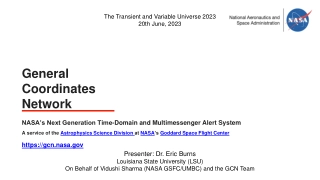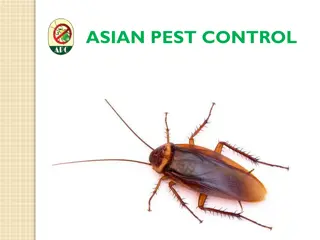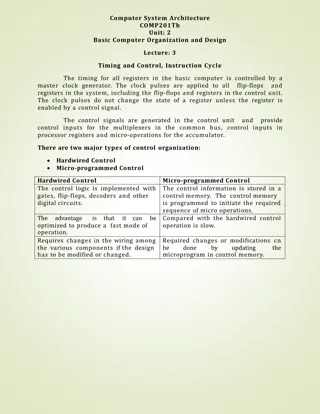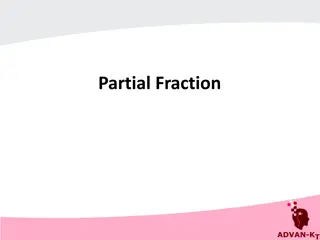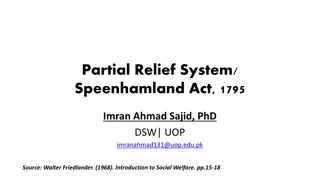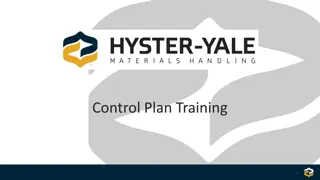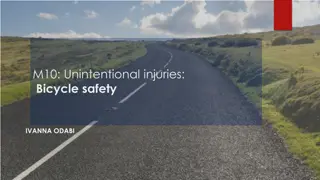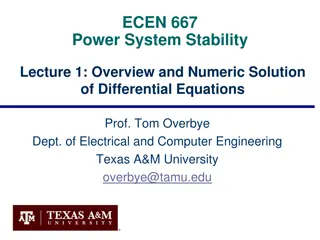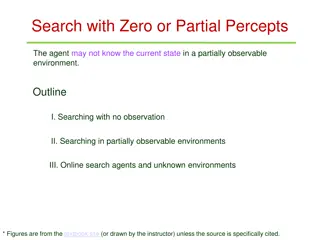Partial Control and Beyond: Controlling Chaotic Transients with Safety Measures
Explore the innovative approach of partial control in chaotic systems to manage chaotic transients and ensure safety, illustrated through collaborative work and sculpting algorithms. The methodology involves finding safe sets and implementing control strategies to navigate through complex dynamics.
Download Presentation

Please find below an Image/Link to download the presentation.
The content on the website is provided AS IS for your information and personal use only. It may not be sold, licensed, or shared on other websites without obtaining consent from the author.If you encounter any issues during the download, it is possible that the publisher has removed the file from their server.
You are allowed to download the files provided on this website for personal or commercial use, subject to the condition that they are used lawfully. All files are the property of their respective owners.
The content on the website is provided AS IS for your information and personal use only. It may not be sold, licensed, or shared on other websites without obtaining consent from the author.
E N D
Presentation Transcript
* M stoles, Madrid, Spain Partial Control and Beyond: Controlling Chaotic Transients with the Safety Function Miguel A. F. Sanju n Nonlinear Dynamics, Chaos and Complex Systems Group Dept. of Physics, Universidad Rey Juan Carlos, Madrid, Spain 1/46
Work in collaboration with Juan Sabuco Gaspar Alfaro Rub n Cape ns James A. Yorke 2/46
Basic Idea of Partial Control Q Admissible trajectories 3/46
Safe points in the slope-three tent map f(x)=3-3 x Q=[-3/2, 3/2] n x + =f ( n x)+ 3 x n u n+1 3/2 -1 +1 -3/2 3/2 4/46
Method to compute the Safe Set: Sculpting Algorithm Every point that belongs to a safe set satisfies the following property: maxdist f(p)+x,S ( )= 0 x 0 u< p S,x x0 J. Sabuco, S. Zambrano, M. A. F. Sanju n and J. A. Yorke. Finding safety in partially controllable chaotic systems. Comm. Nonl. Sci. Num. Sim. 17, 4274 (2012). 5/46
Partial control in the Duffing oscillator The goal is to find a safe set in the Duffing oscillator with a choice of parameters where the Wada property arises. . q = (x, x ) ; f(q) = time-2 map . 0 = 245 sin( ) + t . 0 + 3 15 x x x x Once again we can find a safe set using the algorithm with a control smaller than noise 0 u 0 6/46
Basin of attraction and phase space orbits of the Duffing oscillator P1 P1 P1 P1 P3 P3 P3 P3 7/46
The blue set is our Q: the region we want to stay in Q Q=Q(0) is the box that contains the square [-2,2]x[-2,2] but with some holes (circles of radius 0.2), centered at the periodic attractors 0 x = 0.08 0 u= 0.0475 9/46
Step 1 S(0) is the union of the blue and magenta regions. S(1) is the blue region; In each successive picture, magenta denotes the part of the sculpture that has been removed. 0 x = 0.08 0 u= 0.0475 10/46
Step 1 0 x = 0.08 0 u= 0.0475 11/46
Step 2 0 x = 0.08 0 u= 0.0475 12/46
Step 2 0 x = 0.08 0 u= 0.0475 13/46
The initial set has finally converged to a safe set 0 x = 0.08 0 u= 0.0475 14/46
Safe sets, aymptotic safe sets and admissible safe trajectories 1 1 3 3 3 = . 0 08 0 u = 0475 . 0 0 15/46
Evolution of the safe sets as u0 decreases for a given uo=0.06 = . 0 08 uo=0.05 0 u = 0475 . 0 0 uo=0.0475 uo=0.0471 16/46
Transient chaos in the Lorenz system =10 b=8/3 r=20 The trajectory eventually escape to one of the attractors C+or C- 18/46
Different ways to discretize the Lorenz system 3D map 2D map 1D map Maxima of z x + x ( ) ( ) t t t Poincar section 0 0 19/46
1D map case 20/46
2D map case 22/46
2D map case Z=19 23/46
3D map: Asymptotic safe set The partially controlled dynamics converges to this set 26/46
3D map: Controlled trajectories In yellow the controls are applied every t=1.2 27/46
Comparison of the three maps Comparison of the three controlled trajectories of the z variable by using a 3D, a 2D and a 1D map. Only the 3D is periodic. 29/46
Summary The Lorenz system as a paradigmatic example in Nonlinear Dynamics 30/46
We have developed a new control algorithm based in the partial control method. The goal of the algorithm is to control in a predictable manner when to escape. While partial control has been used as a way to avoid escapes, here we want to adapt it to force the escape in a controlled manner. 31/46
How to control the escape set of an orbit 1. Compute the escape function UN in the region Q. This function depends on : N, f(q) and ??. This step is the most computationally expensive 2. Choose the upper bound of control ??< ??and cut the escape function 3. Extract the escape set. Initial conditions in this set will escape in N iterations by applying every iteration a control |??| ??< ?? 32/46
Case A: Escape in N or less iterations Escape in N=3 or less iterarions Example of a controlled orbit. In red, the escape functions Ukcomputed in the interval [0,1] with N=3, ??= ?.??? and ??= 0.022. Logistic map with ? = ?.? All orbits are forced to escape in 3 or less iterations. Transient chaos occurs in the region Q=[0,1] In blue the escape sets. 33/46
Case B: Escape exactly in N iterations Escape in exactly N=3 iterarions Example of a controlled orbit. In red the escape functions Ukcomputed in the Interval [0,1] with N=3, ??= ?.??? and ??= 0.022. Logistic map ? = ?.? Transient chaos occurs in the region Q=[0,1] All orbits are forced to escape in exactly 3 iterations. In blue the escape sets. 34/46
Case C: Alternating chaotic regions. Controlling the transient between two regions DOUBLE PARABOLA MAP For ? > ? transient chaos appears. Orbits escape from LEFT to RIGHT and viceversa. Goal: control the number of iterations that the orbit takes in each side. 35/46
Case C: Alternating chaotic regions. Controlling the transient between two regions Double parabola map with ? = ?? Left and right escape funtions and the corresponding escape sets, computed for: Nl = 2 and Nr= 3 ??= ?.??? ??= ?.??? 36/46
Controlled Trajectory Controlled trajectory Nl = 20 ; Nr= 30 ??= ?.???? ??= 0.0135 37/46
Beyond partial control: Controlling safety function Goal: approach any orbit to the safe set. In the safe set the control needed is minimum 38/46
Strategy We need to compute the safety function and gradually lead the orbit to the minima of this function (the safe set), where the control needed is minimum. The initial condition x1approaches the safe set. The control applied gradually decreases until the minimum value ??= 0.03. 39/46
Average number of iterations and average control per iteration to reach the safe set. ? = ? ??= ?.?? Initial conditions far from the safe set need more iterations and more control to reach the safe set. 40/46
Variation of the safe set with ??and Here ? = ? is kept fixed Here ??= ?.?? is kept fixed In BLUE the ?0 corresponding to each safe set is plotted. 41/46
Safe sets for different values of ? H non Map Lozi Map 44/46
Summary and Conclusions The partial control method allows to avoid the escape of an orbit from a phase space region in presence of noise with a control smaller than noise. The safe set defines the set where this is posible. We have developed a new control algorithm based in the partial control method, where the goal of the algorithm is to control in a predictable manner when to escape. While partial control has been used as a way to avoid escapes, with the new algorithm we are able to force the escape in a controlled manner. Going beyond the partial control, and with the help of the safety function we can apply the method for any point in the region Q, not necessarily in the safe set. We have applied the method with the safety function for 2D maps like the H non map and the Lozi map 45/46
Thank you for your attention miguel.sanjuan@urjc.es Juan Sabuco, Miguel A. F. Sanju n and James A. Yorke. Dynamics of Partial Control. Chaos 22, 047507, (2012) R. Cape ns, J. Sabuco, M. A.F. Sanju n and J. A. Yorke. Partially controlling transient chaos in the Lorenz equations. Philosophical Transactions of the Royal Society A 375, 2088, (2017) R. Cape ns, J. Sabuco and M. A.F. Sanju n. Partial control of chaos: how to avoid undesirable behaviors with small controls in presence of noise. Discrete and Continuous Dynamical Systems - Series B 2, 3237-3274, (2018) Ruben Cape ns, Juan Sabuco, and Miguel A.F. Sanju n. A new approach of the partial control method in chaotic systems. Nonlinear Dynamics 98, 873--887 (2019) Gaspar Alfaro, Rub n Cape ns, and Miguel A. F. Sanjuan. Forcing the escape: Partial control of escaping orbits from a transient chaotic region. Nonlinear Dynamics 104, 1603 1612 (2021) Rub n Cape ns and Miguel A. F. Sanju n. Beyond partial control: Controlling chaotic transients with the safety function. Nonlinear Dynamics 107, 2903 2910 (2022) Rub n Cape ns & Miguel A. F. Sanju n. Controlling chaotic transients in the H non and the Lozi map with the safety function, Journal of Difference Equations and Applications (2022) DOI: 10.1080/10236198.2022.2063050 46/46



